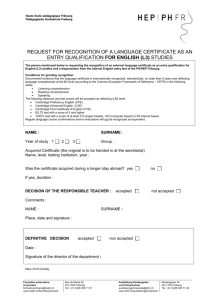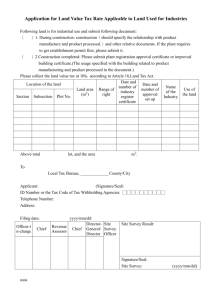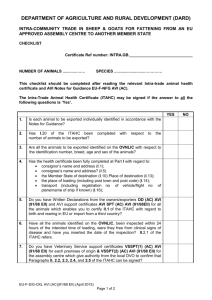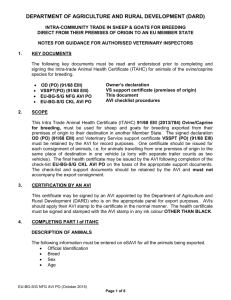(AVIs) Word - Department of Agriculture and Rural Development
advertisement
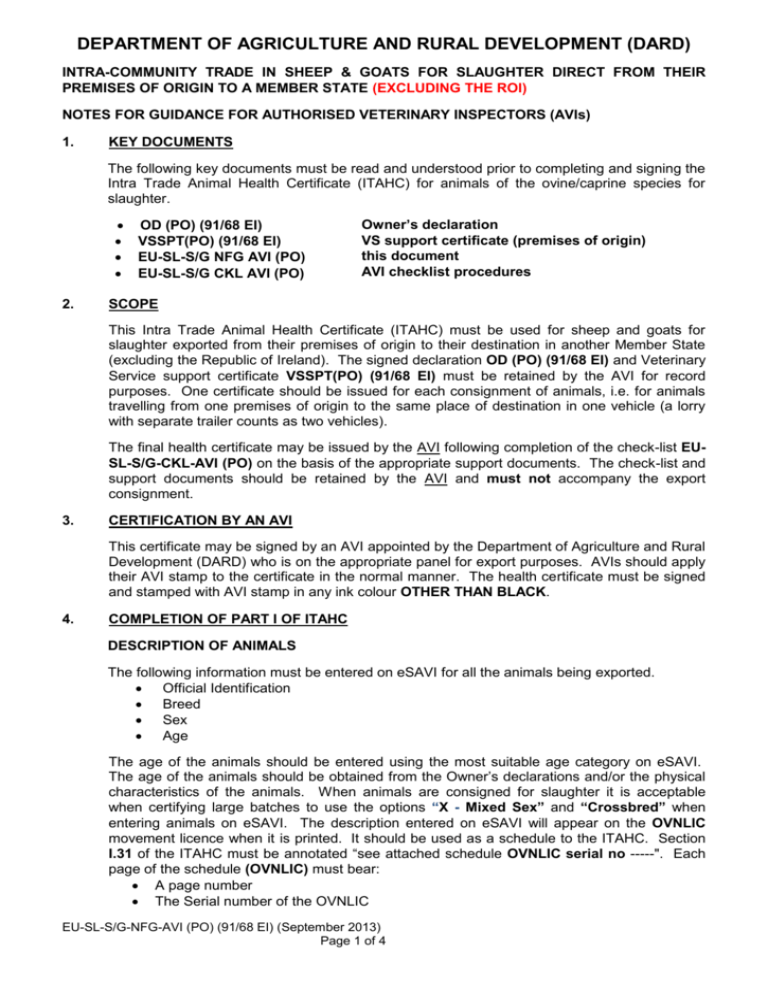
DEPARTMENT OF AGRICULTURE AND RURAL DEVELOPMENT (DARD) INTRA-COMMUNITY TRADE IN SHEEP & GOATS FOR SLAUGHTER DIRECT FROM THEIR PREMISES OF ORIGIN TO A MEMBER STATE (EXCLUDING THE ROI) NOTES FOR GUIDANCE FOR AUTHORISED VETERINARY INSPECTORS (AVIs) 1. KEY DOCUMENTS The following key documents must be read and understood prior to completing and signing the Intra Trade Animal Health Certificate (ITAHC) for animals of the ovine/caprine species for slaughter. 2. OD (PO) (91/68 EI) VSSPT(PO) (91/68 EI) EU-SL-S/G NFG AVI (PO) EU-SL-S/G CKL AVI (PO) Owner’s declaration VS support certificate (premises of origin) this document AVI checklist procedures SCOPE This Intra Trade Animal Health Certificate (ITAHC) must be used for sheep and goats for slaughter exported from their premises of origin to their destination in another Member State (excluding the Republic of Ireland). The signed declaration OD (PO) (91/68 EI) and Veterinary Service support certificate VSSPT(PO) (91/68 EI) must be retained by the AVI for record purposes. One certificate should be issued for each consignment of animals, i.e. for animals travelling from one premises of origin to the same place of destination in one vehicle (a lorry with separate trailer counts as two vehicles). The final health certificate may be issued by the AVI following completion of the check-list EUSL-S/G-CKL-AVI (PO) on the basis of the appropriate support documents. The check-list and support documents should be retained by the AVI and must not accompany the export consignment. 3. CERTIFICATION BY AN AVI This certificate may be signed by an AVI appointed by the Department of Agriculture and Rural Development (DARD) who is on the appropriate panel for export purposes. AVIs should apply their AVI stamp to the certificate in the normal manner. The health certificate must be signed and stamped with AVI stamp in any ink colour OTHER THAN BLACK. 4. COMPLETION OF PART I OF ITAHC DESCRIPTION OF ANIMALS The following information must be entered on eSAVI for all the animals being exported. Official Identification Breed Sex Age The age of the animals should be entered using the most suitable age category on eSAVI. The age of the animals should be obtained from the Owner’s declarations and/or the physical characteristics of the animals. When animals are consigned for slaughter it is acceptable when certifying large batches to use the options “X - Mixed Sex” and “Crossbred” when entering animals on eSAVI. The description entered on eSAVI will appear on the OVNLIC movement licence when it is printed. It should be used as a schedule to the ITAHC. Section I.31 of the ITAHC must be annotated “see attached schedule OVNLIC serial no -----". Each page of the schedule (OVNLIC) must bear: A page number The Serial number of the OVNLIC EU-SL-S/G-NFG-AVI (PO) (91/68 EI) (September 2013) Page 1 of 4 The ITAHC serial number The schedule must be stapled inside the health certificate and the AVI should "fan" and stamp over the pages of the schedule and certificate. One corner of the schedule and certificate should be folded over and stamped also. OFFICIAL IDENTIFICATION OF SHEEP AND GOATS INTENDED FOR EXPORT Sheep leaving any premises in Northern Ireland must be individually identified with two matching identifiers (usually tags), one of which must carry an EID device. This identification meets the requirements for export to GB or EU member states. Identification must comply with the requirements of The Sheep and Goats (Records, Identification and Movement) Order (NI) 2009. Goats born or first tagged after 31 December 2009 for export to EU Member States including the Republic of Ireland must be individually identified with 2 matching identifiers (usually tags) one of which must carry an EID device. Goats born or first tagged before 31 December 2009 for export to EU Member States including the Republic of Ireland must be individually identified with 2 matching identifiers (usually tags) one of which may carry an EID device. Identification must comply with the requirements of The Sheep and Goats (Records, Identification and Movement) Order (NI) 2009. PLACE OF LOADING I.14 of the certificate refers. The place of loading will be the premises of origin (see I.12 of the certificate) where the final export health certificate is issued. 5. COMPLETING PART II OF THE ITAHC II.1 COUNTRY OF BIRTH (One of the options should be deleted) The AVI should obtain a written declaration OD (PO) (91/68 EI) from the owner/exporter with regard to the country in which the animals have been born and reared. Flock records should be checked to verify this and, if necessary, a photocopy taken. Sheep or goats which have been legally imported into the European Community from a third country in accordance with harmonised Community rules or legally imported into NI from a third country in accordance with an import licence issued by DARD and subsequently resident in NI for at least 30 days, comply with the requirement at II.1 “second option”. If the AVI has reason to doubt the validity of the declaration, the local DVO should be consulted. II.2.1 CLINICAL INSPECTION The examination should be carried out within 24 hours of loading. For the purposes of export certification, EC legislation does not differentiate between the terms inspection and examination and in general the terms inspection and visual examination are synonymous. The pre-export examination or inspection should consist of a visual appraisal and if deemed appropriate, physical examination of the animals for export. AVIs must use their professional judgement to decide what is required in order to ensure that no animal is exported which shows clinical signs of disease, and that animals are fit to travel to their intended destination. Each animal subject to an inspection must be appraised as an individual. The date of the inspection should be inserted in ink of a colour other than black at II 2.1 of the ITAHC. II.2.2 – II.2.5 NOTIFIABLE DISEASE CLEARANCE AVIs may certify II. 2.2, 2.3, 2.4 and 2.5 of the ITAHC on behalf of the Department, provided written authority to do so has been obtained from the local DVO on a Veterinary Service support certificate VSSPT(PO) (91/68 EI) II.3. - 3.1 RESIDENCY AND STANDSTILL EU-SL-S/G-NFG-AVI (PO) (91/68 EI) (September 2013) Page 2 of 4 II.3.1 (first part re 21 day residency and biungulates from third countries) can be supported either by reference to the Owner’s Declaration (OD (PO) (91/68 EI)) or the flock records which may be checked to provide verification. If necessary, take a copy for your records. II.3.1 (either/or) option - since the sheep are moving directly from a single holding to the slaughterhouse of destination the first option i.e. the one relating to introduced animals may be deleted and the second option retained. II.4.1 - 4.3 TRANSPORT II.4.1 Cleansing & Disinfection of Vehicle etc The AVI must obtain a written declaration from the owner/transporter/exporter (OD (PO) (91/68 EI)) that the animals will be transported from the holding in vehicles previously cleansed and disinfected with a DARD approved disinfectant and “in such a way as to provide effective protection of the animals’ health status”. This means transport without coming into contact with cloven-hoofed animals other than those of a similarly certified level of health status, i.e. for slaughter. II.4.2 Date of Commencement of Journey The date when the consignment is due to start its journey should be entered. II.4.3 Fitness for Transport See Welfare Section below BLUETONGUE Northern Ireland is officially free from Bluetongue so Part II, Section Bluetongue (BT) – exemption from the exit ban should all be deleted even in the case of animals moving through a restricted area to a free area provided they are for direct slaughter. 6. COMPLETION OF ITAHC Having completed all the checks, and ensuring the ITAHC is fully completed and all appropriate deletions have been made the AVI must sign and stamp the certificate with the AVI’s official stamp in ink of any colour other than black. In addition, an ITAHC printed in the language of the country of destination must accompany the consignment to its final destination. The date and AVI stamp should be applied to the unsigned foreign language version. Parts I and II of the completed (English language) ITAHC must be placed on top of the MS language Parts I and II, then stapled and fan stamped together as a single certificate to accompany the consignment to the destination premises. 7. SENDING OF TRACES NOTIFICATION AND CONFIRMATION OF EXPORT ON Esavi In order to meet the requirement for notification of animal movements to other Member States, AVIs must complete a TRACES notification immediately following the signature of the ITAHC. The export must also be declared on e-SAVI. This process removes the animals exported out of the exporting flock list. 8. WELFARE Council Regulation 1/2005 lays down the provisions for the protection of animals during transport. The Regulation is enforced in Northern Ireland by the Welfare of Animals (Transport) Regulations (NI) 2006. Article 3 of the EU Regulation requires that animals must be fit for the intended journey before the journey starts and must remain sufficiently fit throughout the journey and that no person shall transport them in a way likely to cause injury or undue suffering. This means that animals should be healthy enough to tolerate the entire journey they are about to make (including loading, unloading and any journey breaks) with no or very little adverse effect on them and that the journey should not cause the animals any suffering or injury. Animals not considered to be fit for transport include those that: EU-SL-S/G-NFG-AVI (PO) (91/68 EI) (September 2013) Page 3 of 4 are unable to move independently without pain or to walk unassisted; present a severe open wound, or prolapse; are pregnant females for whom 90% or more of the expected gestation period has already passed, or females who have given birth in the previous week; are new-born mammals in which the navel has not completely healed; are lambs of less than one week, unless they are transported less than 100 km. As certifying AVI you must reject any animal where, in your professional judgement, there is doubt over its fitness on the intended journey. Further detailed guidance on the fitness requirements can be obtained from the DARD website www.dardni.gov.uk. 9. TRANSPORTER AUTHORISATION AND VEHICLE CERTIFICATION Articles 10 and 11 of Council Regulation 1/2005 require transporters of animals to be authorised, and Article 18 requires that the vehicle or trailer used to transport animals on long journeys has a certificate of approval. For journeys over 65km (approx. 40 miles), transporters must: Hold a transporter authorisation. If transporting horses, farmed animals or poultry, ensure drivers and attendants are in possession of a certificate of competence (from January 2008). Demonstrate that they have appropriate staff and equipment to transport animals in a proper way and to have no record of serious infringements of animal welfare legislation in the preceding 3 years. Complete an Animal Transport Certificate for each journey. For long journeys (over 8 hours) transporters must also: Be in possession of a long journey transporter authorisation. If the vehicle is used for transporting farmed animals and horses, get it inspected and approved. Ensure contingency plans in case of emergencies are in place. Ensure the Journey Log has been completed (for journeys of unregistered horses and livestock). 10. JOURNEY LOGS Journey logs are required for all journeys exceeding 8 hours to other EU Member States. These must be submitted to the DVO for approval prior to departure. The format of the log is laid down in Annex II of Council Regulation 1/2005. 11. RETENTION OF SUPPORT CERTIFICATION Copies of all support documentation (i.e. Owner’s Declarations, Checklist and Veterinary Service support certificate) should be retained for 2 years by the certifying AVI. In addition you must keep a TRUE (i.e. carbon, photo or scanned) copy of the completed ITAHC for 2 years. EU-SL-S/G-NFG-AVI (PO) (91/68 EI) (September 2013) Page 4 of 4




